|
|
|
Sort Order |
|
|
|
Items / Page
|
|
|
|
|
|
|
| Srl | Item |
| 1 |
ID:
155201
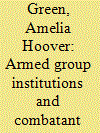

|
|
|
|
|
| Summary/Abstract |
Ex-combatants who fought with the Salvadoran Army during El Salvador’s 1980–92 civil war often recall being ‘captured’, rather than recruited, suffering beatings and humiliation in the course of training, and fighting without a sense of purpose or direction. Those who served with rebel forces, by contrast, recall fatigue and frustration with new routines, but seldom hazing or abuse; most also recalled deep, ongoing instruction about the purpose and goals of the war. This comparison highlights the broad variation in armed groups’ formal institutions for socialization, a topic that political scientists have only recently begun to examine in depth. The Salvadoran case also emphasizes some shortcomings of the existing literature, which may elide the differing effects of different formal institutions, treat individual institutions as operating independently on combatant behavior, and/or fail to map complex causal processes intervening between institutions and behavior. This article takes as its starting point the observation that many armed group institutions – including recruitment, military training, political training, and disciplinary regimes – are components of the process known more generally as ‘combatant socialization’. Examining specific institutional processes associated with combatant socialization allows for the generation of more refined and specific theories of combatant socialization as both a causal variable and an outcome. At the same time, treating armed group institutions as related elements of a broader process, rather than as fully separate institutions, may also advance understandings of the effects of these institutions. I demonstrate that the implementation and content of formal institutions for socialization varied significantly both across and within groups in El Salvador; building on this analysis, I lay out several potential directions for comparative research.
|
|
|
|
|
|
|
|
|
|
|
|
|
|
|
|
| 2 |
ID:
155198
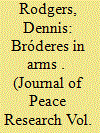

|
|
|
|
|
| Summary/Abstract |
Drawing on longitudinal ethnographic research that has been ongoing since 1996, this article explores the way that gangs socialize individuals into violent norms and practices in Nicaragua. It shows how different types of gang violence can be related to distinct socialization processes and mechanisms, tracing how these dynamically articulate individual agency, group dynamics and contextual circumstances, albeit in ways that change over time. As such, the article highlights how gang socialization is not only a variable multilayered process, but also a very volatile one, which suggests that the socialization of violence and its consequences are not necessarily enduring.
|
|
|
|
|
|
|
|
|
|
|
|
|
|
|
|
| 3 |
ID:
155195


|
|
|
|
|
| Summary/Abstract |
Research on socialization can obscure the agency of its targets, presenting socialization as a uni-directional process shaping beliefs and behaviors. This assumption is even stronger for the military, a totalizing institution often portrayed as fashioning its members into violence professionals through a top-down process of domination. In contrast, this article argues that even powerful socialization processes are not omnipotent, and that individuals retain a measure of agency even under pervasive social control. Drawing on the case of the Israel Defense Force during the Second Intifada, it shows that norms inculcated during military socialization can be undermined by the more ambiguous conditions of deployment. When soldiers also subscribe to competing norms and receive social support for their dissent, resistance can emerge, increase, and become more overt. Analysis of resistance to violence underscores the power of military socialization while drawing attention to its limits. It therefore challenges homogenizing views of soldiers, illuminating the processes through which military violence is produced and curbed.
|
|
|
|
|
|
|
|
|
|
|
|
|
|
|
|
| 4 |
ID:
155203


|
|
|
|
|
| Summary/Abstract |
The sexual exploitation and abuse (SEA) of civilians by international peacekeepers is a form of post-conflict violence that is pernicious and understudied, but far from inevitable. However, there are very few cross-mission analyses of the phenomenon. This article considers whether the socialization experiences of troops in two environments, the contributing state military and the peacekeeping mission itself, help to explain the observed variation in SEA. Drawing on a dataset of SEA allegations between 2007 and 2014, as well as the first publicly available data from the United Nations that identify the nationalities of alleged perpetrators, this article analyzes the layered nature of socialization through the lens of SEA. Specifically, this article presents evidence that SEA is positively associated with disciplinary breakdowns at the peacekeeping mission’s lower levels of command, and argues that a peacekeeping mission may carry its own norms and socializing processes that either constrain or facilitate the emergence and endurance of SEA.
|
|
|
|
|
|
|
|
|
|
|
|
|
|
|
|
| 5 |
ID:
155196
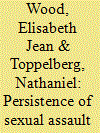

|
|
|
|
|
| Summary/Abstract |
What accounts for the puzzling persistence of sexual assault of both women and men within the ranks of the US military? Despite increasing efforts to end this intraforce violence, sexual assault of women persists at levels comparable to those in the civilian population and significantly higher than that of other crimes (data challenges prevent comparing rates for men). Drawing on recent analysis of rape as a practice rather than a strategy of war, we suggest the answer lies in the socialization not only of recruits but also of officers. We draw on an original typology of socialization processes and analysis of four well-documented cases to suggest the following account of why sexual assault persists. First, informal socialization processes (including sexualized hazing) trivialize sexual harassment and assault, establish assault as an appropriate form of punishment (including of those transgressing military gender norms), and license retaliation against victims who report. Second, officers sometimes sexually harass and assault subordinates, thereby endorsing similar acts by servicemembers under their command. Third, formal socialization processes of enlisted men and women, despite recent reforms, continue to reproduce a masculinity that undermines policies that seek to prevent sexual assault, in part because it fails to override these unauthorized and illegal socialization processes. Finally, the socialization of officers, combined with problematic incentive structures, undercuts efforts to end the de facto tolerance of sexual abuse by many officers. In our emphasis on horizontal as well as top-down socialization processes, and on those that subvert official policies as well as those that seek to inculcate them, we also contribute to scholarly understanding of socialization within organizations more generally.
|
|
|
|
|
|
|
|
|
|
|
|
|
|
|
|
| 6 |
ID:
155194
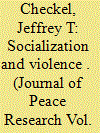

|
|
|
|
|
| Summary/Abstract |
This article sets the stage for a special issue exploring group-level dynamics and their role in producing violence. My analytic focus is socialization, or the process through which actors adopt the norms and rules of a given community. I argue that it is key to understanding violence in many settings, including civil war, national militaries, post-conflict societies and urban gangs. While socialization theory has a long history in the social sciences, I do not simply pull it off the shelf, but instead rethink core features of it. Operating in a theory-building mode and drawing upon insights from other disciplines, I highlight its layered and multiple nature, the role of instrumental calculation in it and several relevant mechanisms – from persuasion, to organized rituals, to sexual violence, to violent display. Equally important, I theorize instances where socialization is resisted, as well as the (varying) staying power of norms and practices in an individual who leaves the group. Empirically, the special issue explores the link between socialization and violence in paramilitary patrols in Guatemala; vigilantes in the Bosnian civil war; gangs in post-conflict Nicaragua; rebel groups in the Democratic Republic of Congo, El Salvador, Sierra Leone and Uganda; post-conflict peacekeepers; and the US and Israeli military. By documenting this link, we contribute to an emerging research program on group dynamics and conflict.
|
|
|
|
|
|
|
|
|
|
|
|
|
|
|
|
| 7 |
ID:
155193


|
|
|
| 8 |
ID:
155197


|
|
|
|
|
| Summary/Abstract |
When the Guatemalan civil war ended in 1996, the Peace Accords required the demobilization of the civil patrols. Yet, nearly two decades after the end of the war, the ex-patrollers remain organized and active. At first glance, the persistence of Guatemala’s civil patrols sounds like a triumph of socialization: the men enrolled in the civil patrols were effectively socialized during the war, so they continue patrolling today. This argument is seductively simple, but it is incorrect. Using process tracing to analyze historical documents and interviews with former civil patrollers, I show that the military did not succeed in socializing most of its patrollers. The military was, however, remarkably successful at socializing civilians in conflict zones. After enduring a ferocious scorched earth campaign followed by re-education, civilians either learned to fear and comply with the military and the civil patrols, or they internalized the military-promulgated narrative that repression is necessary to guarantee security. Both these outcomes facilitate patrolling in postwar Guatemala, where many civilians in war-affected areas either embrace or tolerate extralegal security patrolling as a means of preventing crime from spreading to their communities. Theoretically, the case of Guatemala’s civil patrols expands our knowledge of socialization in militias and civil defense forces. Mass socialization of group members is not necessary for an armed group to retain its influence in the long term, even after a conflict has ended. Additionally, socialization occurs not just within groups, but also dynamically and interactively across group boundaries. To fully understand the trajectories of armed groups, it is important to analyze both socialization within armed groups and the socialization of the broader civilian population.
|
|
|
|
|
|
|
|
|
|
|
|
|
|
|
|
| 9 |
ID:
155199
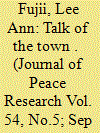

|
|
|
|
|
| Summary/Abstract |
How do people come to participate in violent display? By ‘violent display’, I mean a collective effort to stage violence for people to see, notice, or take in. Violent displays occur in diverse contexts and involve a range of actors: state and non-state, men and women, adults and children. The puzzle is why they occur at all given the risks and costs. Socialization helps to resolve this puzzle by showing how actors who have consciously adopted or internalized group norms might take part, despite the risks. Socialization is more limited in explaining how and why actors who are not bound by group norms also manage to put violence on display. To account for these other pathways, I propose a theory of ‘casting’. Casting is the process by which actors take on roles and roles take on actors. Roles enable actors to do things they would not normally do. They give the display its form, content, and meaning. Paying attention to this process reveals how violent displays come into being and how the most eager actors as well as unwitting and unwilling participants come to take part in these grisly shows. To explore variation in the casting process, I investigate violent displays that occurred in two different contexts: the Bosnian war and Jim Crow Maryland. Data come from interviews, trial testimonies, and primary sources.
|
|
|
|
|
|
|
|
|
|
|
|
|
|
|
|
| 10 |
ID:
155202
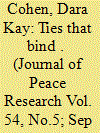

|
|
|
|
|
| Summary/Abstract |
How do armed groups use violence to create social ties? What are the conditions under which such violence takes place? In this article, I describe how armed groups use one type of atrocity, wartime rape, to create social bonds between fighters through a process of combatant socialization. As a form of stigmatizing, public, and sexualized violence, gang rape is an effective method to communicate norms of masculinity, virility, brutality, and loyalty between fighters. Drawing on literature about socialization processes, I derive a set of hypotheses about individual-level factors that may influence vulnerability to violent socialization, including age, previous socialization experiences, and physical security. I analyze the support for these hypotheses using newly available survey data from former fighters in the Democratic Republic of the Congo. The results show the broad applicability of considering group violence as a form of social control within armed groups, suggest some of the limits of violent socialization, and have implications for both theory and policy.
|
|
|
|
|
|
|
|
|
|
|
|
|
|
|
|
|
|
|
|
|